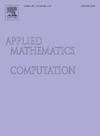Remaining useful life estimation considering threshold epistemic uncertainty with uncertain differential equation
IF 3.5
2区 数学
Q1 MATHEMATICS, APPLIED
引用次数: 0
Abstract
Remaining useful life (RUL) prediction is one of the key problems in equipment operation and maintenance. In some engineering practices, sufficient degradation observations can not be obtained due to limitations in cost, technology, and time. Under these situations, several degradation models are established using uncertain processes, and based on which the RULs are predicted under belief reliability theory. Although these methods showed advantages in dealing with small sample sizes, they all regarded the failure threshold as a known constant. However, as the system will be used by a diverse range of users, the failure threshold can vary appreciably with different using scenarios. Furthermore, due to the unclear understanding and insufficient collection of the actual operation process by users, the determination of the failure threshold is quite subjective. If the threshold is simply regarded as a known constant, it will cause inaccuracies in the reliability assessment and the scheduling of maintenance, which may further lead to unnecessary losses. Therefore, this work develops a method to estimate RUL with an uncertain failure threshold based on a degradation model constructed by the uncertain differential equation. Unknown parameters in the established degradation model are estimated by the method of moment based on residuals to alleviate the problem in which observation intervals are not close enough. The effectiveness of the proposed methodology is verified through a degradation data set.
不确定微分方程中考虑阈值认知不确定性的剩余使用寿命估计
剩余使用寿命(RUL)预测是设备运行维护中的关键问题之一。在一些工程实践中,由于成本、技术和时间的限制,无法获得充分的降解观察结果。在这种情况下,利用不确定过程建立了若干退化模型,并在此基础上根据信度理论对规则进行了预测。虽然这些方法在处理小样本量时表现出优势,但它们都将失效阈值视为已知常数。然而,由于系统将由不同范围的用户使用,因此故障阈值可能随着不同的使用场景而明显变化。此外,由于用户对实际操作过程认识不清、收集不充分,故障阈值的确定具有较大的主观性。如果简单地将阈值作为一个已知的常数,将导致可靠性评估和维护计划的不准确,从而可能导致不必要的损失。因此,本文提出了一种基于不确定微分方程构建的退化模型来估计具有不确定失效阈值的RUL的方法。采用基于残差的矩量法对退化模型中的未知参数进行估计,解决了观测区间不够接近的问题。通过退化数据集验证了所提方法的有效性。
本文章由计算机程序翻译,如有差异,请以英文原文为准。
求助全文
约1分钟内获得全文
求助全文
来源期刊
CiteScore
7.90
自引率
10.00%
发文量
755
审稿时长
36 days
期刊介绍:
Applied Mathematics and Computation addresses work at the interface between applied mathematics, numerical computation, and applications of systems – oriented ideas to the physical, biological, social, and behavioral sciences, and emphasizes papers of a computational nature focusing on new algorithms, their analysis and numerical results.
In addition to presenting research papers, Applied Mathematics and Computation publishes review articles and single–topics issues.

 求助内容:
求助内容: 应助结果提醒方式:
应助结果提醒方式:


